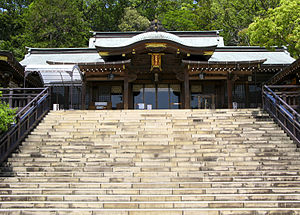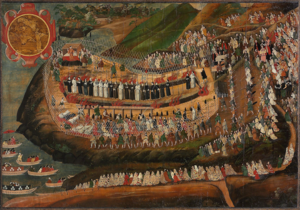Country:
Region:
City:
Latitude and Longitude:
Time Zone:
Postal Code:
IP information under different IP Channel
ip-api
Country
Region
City
ASN
Time Zone
ISP
Blacklist
Proxy
Latitude
Longitude
Postal
Route
Luminati
Country
ASN
Time Zone
Asia/Tokyo
ISP
Nagasaki Cable Media Inc.
Latitude
Longitude
Postal
IPinfo
Country
Region
City
ASN
Time Zone
ISP
Blacklist
Proxy
Latitude
Longitude
Postal
Route
db-ip
Country
Region
City
ASN
Time Zone
ISP
Blacklist
Proxy
Latitude
Longitude
Postal
Route
ipdata
Country
Region
City
ASN
Time Zone
ISP
Blacklist
Proxy
Latitude
Longitude
Postal
Route
Popular places and events near this IP address

Nagasaki
Core city in Kyushu, Japan
Distance: Approx. 841 meters
Latitude and longitude: 32.74472222,129.87361111
Nagasaki (Japanese: 長崎, Hepburn: Nagasaki) (IPA: [naɡaꜜsaki] ; lit. "Long Cape"), officially known as Nagasaki City (長崎市, Nagasaki-shi), is the capital and the largest city of the Nagasaki Prefecture on the island of Kyushu in Japan. Founded by the Portuguese, the port of Nagasaki became the sole port used for trade with the Portuguese and Dutch during the 16th through 19th centuries.

Nagasaki Prefecture
Prefecture of Japan
Distance: Approx. 827 meters
Latitude and longitude: 32.75,129.8675
Nagasaki Prefecture (長崎県, Nagasaki-ken) is a prefecture of Japan, mainly located on the island of Kyūshū, although it also includes a number of islands off Kyūshū's northwest coast - including Tsushima and Iki. Nagasaki Prefecture has a population of 1,314,078 (1 June 2020) and has a geographic area of 4,130 km2 (1,594 sq mi). Nagasaki Prefecture borders Saga Prefecture to the northeast.

Nagasaki Naval Training Center
Distance: Approx. 811 meters
Latitude and longitude: 32.74503333,129.87348056
The Nagasaki Naval Training Center (長崎海軍伝習所, Nagasaki Kaigun Denshū-jo) was a naval training institute, between 1855 when it was established by the government of the Tokugawa shogunate, until 1859, when it was transferred to Tsukiji in Edo. During the Bakumatsu period, the Japanese government faced increasing incursions by ships from the Western world, intent on ending the country's two centuries of isolationist foreign policy. These efforts cumulated in the landing of United States commodore Matthew Perry in 1854, resulting in the Treaty of Kanagawa and the opening of Japan to foreign trade.

Twenty-Six Martyrs Museum and Monument
Memorial in Nagasaki, Japan
Distance: Approx. 507 meters
Latitude and longitude: 32.75472222,129.87166667
The Twenty-Six Martyrs Museum and Monument were built on Nishizaka Hill in Nagasaki, Japan in June 1962 to commemorate the 100th anniversary of the canonization by the Roman Catholic Church of the Christians executed on the site on February 5, 1597. The 26 people, a mixture of 20 native Japanese Christians and six foreign priests (four Spaniards, one Mexican and one Portuguese from India) had been arrested in Kyoto and Osaka on the order of Toyotomi Hideyoshi, the national ruler, for preaching Christianity. They were imprisoned, then later marched through the snow to Nagasaki, so that their execution might serve as a deterrent to Nagasaki's large Christian population.

Suwa Shrine (Nagasaki)
Shinto shrine in Nagasaki, Japan
Distance: Approx. 595 meters
Latitude and longitude: 32.75444444,129.88166667
Suwa Shrine (諏訪神社, suwa jinja) is the major Shinto shrine of Nagasaki, Japan, and one of the major locations of the Nagasaki Kunchi, originally celebrated on the ninth day of the ninth lunar month and now celebrated on the fixed dates of October 7 to October 9. It is located in the northern part of the city, on the slopes of Mount Tamazono, and features a 277-step stone staircase leading up the mountain to the various buildings that comprise the shrine. Suwa Shrine was established as a way of stopping and reverting the conversion to Christianity that was taking place in Nagasaki.

Nagasaki Museum of History and Culture
Mosque in Nagasaki, Japan
Distance: Approx. 348 meters
Latitude and longitude: 32.7528,129.8796
The Nagasaki Museum of History and Culture (長崎歴史文化博物館, Nagasaki Rekishi Bunka Hakubutsukan) in Nagasaki, Japan is one of the few museums in Japan devoted to the theme of "overseas exchange". The museum holds 48,000 items in its collection, including historical documents and arts and crafts, that tell the story of Nagasaki as the sole window opened to foreign countries during the period of national isolation. The museum also contains a reconstruction of part of the Nagasaki Magistrate's Office called bugyōsho, a local agency of the central government in the Edo period.

Megane Bridge
Japanese stone arch bridge in Nagasaki
Distance: Approx. 656 meters
Latitude and longitude: 32.747207,129.880087
Meganebashi (眼鏡橋) or Spectacles Bridge, over the Nakashima River (中島川) was built in Nagasaki in 1634 by the Chinese monk Mokusunyoujo who was in the second generation of Chinese monks living at Kofukuji Temple. It is said to be the oldest stone arch bridge in Japan along with Edo's Nihonbashi bridge and Iwakuni's Kintaikyou bridge and has been designated as an Important Cultural Property. Megane Bridge is also part of the first group of bridges built over Nakashima river.

Nagasaki Kunchi
Distance: Approx. 618 meters
Latitude and longitude: 32.754125,129.88211111
Kunchi (くんち), also Nagasaki Kunchi (長崎くんち) or Nagasaki Okunchi (長崎おくんち), is the most famous festival held in Nagasaki, Japan. From October 7–9 the presentations of the festival, which vividly reflect Nagasaki's colourful history, spill over from the three festival sites into the streets and create an atmosphere of celebration throughout the city.

Nagasaki Station
Railway station in Nagasaki, Nagasaki Prefecture, Japan
Distance: Approx. 524 meters
Latitude and longitude: 32.752832,129.8705
Nagasaki Station (長崎駅, Nagasaki-eki) is a railway station in Nagasaki, Nagasaki Prefecture, Japan, operated by the Kyushu Railway Company (JR Kyushu). It is the terminus of the Nishi Kyushu Shinkansen and the Nagasaki Main Line, as well as the westernmost high-speed Shinkansen railway station in Japan. The station is connected by the Kamome Shinkansen service and the Relay Kamome limited express to Hakata, and by the Seaside Liner rapid service to Sasebo.

Shōfuku-ji (Nagasaki)
Buddhist temple in Nagasaki Prefecture, Japan
Distance: Approx. 141 meters
Latitude and longitude: 32.753,129.87693
Shōfuku-ji (聖福寺) is an Ōbaku Zen temple in Nagasaki, Nagasaki, Japan. Its honorary sangō prefix is Manjusan (万寿山). Shōfuku-ji was the fourth of a series of temples built in the 17th century by the Chinese community of Nagasaki.

Fukusai-ji
Buddhist temple in Nagasaki Prefecture, Japan
Distance: Approx. 213 meters
Latitude and longitude: 32.75353,129.87465
Fukusai-ji (福済寺) is an Ōbaku Zen temple in Nagasaki, Nagasaki, Japan. Its honorary sangō prefix is Bunshizan (分紫山).

Great Genna Martyrdom
1622 execution of 55 Christians in Nagasaki
Distance: Approx. 489 meters
Latitude and longitude: 32.75444444,129.87166667
The Great Genna Martyrdom (元和の大殉教, Genna no daijunkyō), also known as the Great Martyrdom of Nagasaki, was the execution of 55 foreign and domestic Catholics killed together at Nishizaka Hill in Nagasaki, Japan, on 10 September 1622. Beginning in 1614, Christianity was banned in Japan and a smuggling incident concerning two foreign missionaries prompted the killing. The mass execution was part of the persecution of Christians in Japan by Tokugawa Hidetada, the second Shogun of the Tokugawa shogunate.
Weather in this IP's area
few clouds
19 Celsius
19 Celsius
19 Celsius
19 Celsius
1021 hPa
72 %
1021 hPa
1019 hPa
10000 meters
1.56 m/s
1.64 m/s
94 degree
17 %
06:40:41
17:27:24